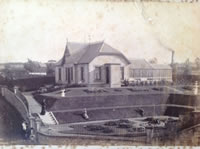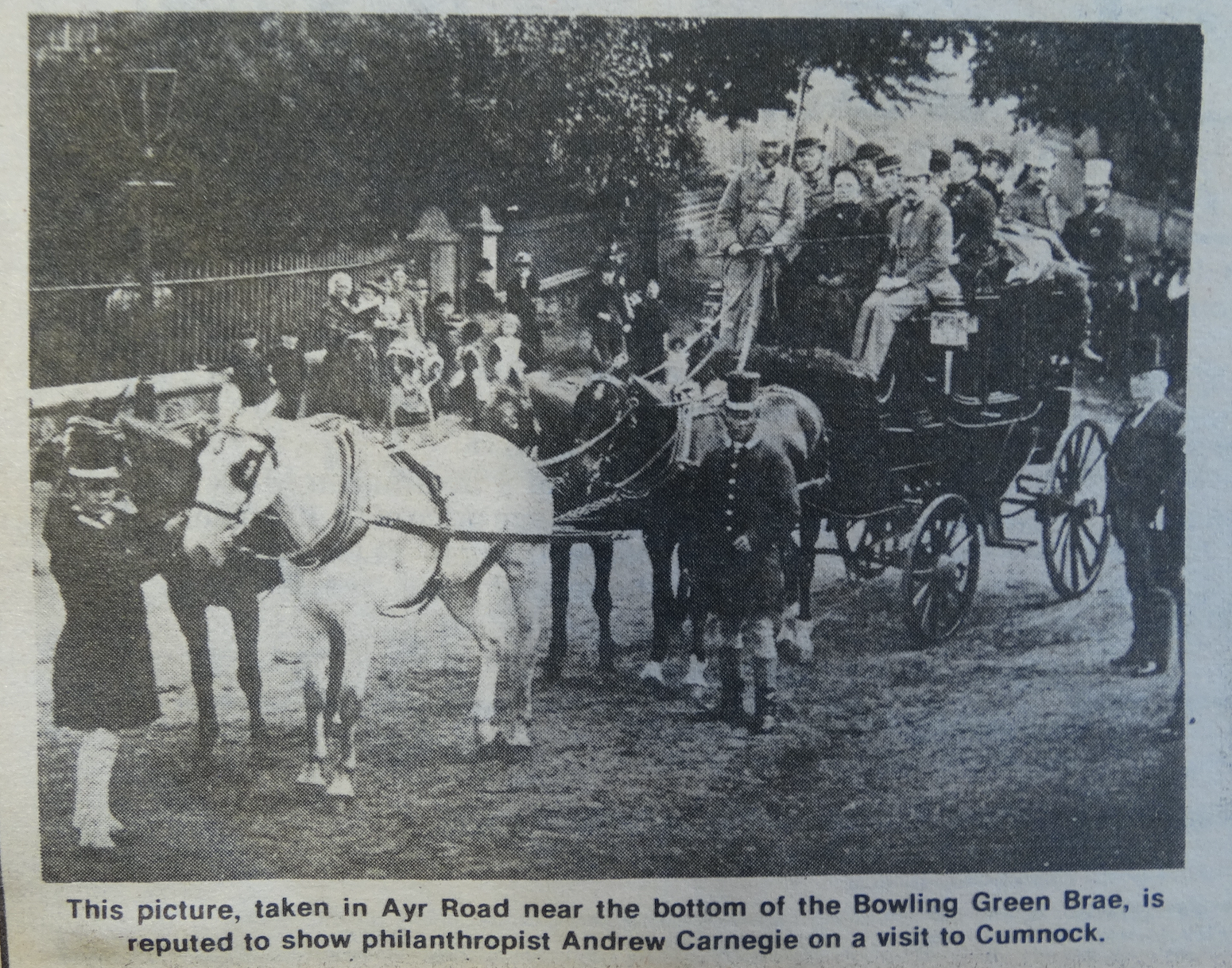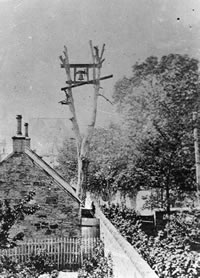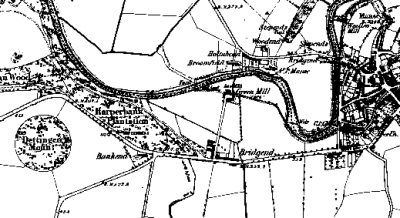Grace Dickie McKerrow (1850-1906) was born in 1850, the fourth child of William McKerrow (b.1815 d.1855) and Margaret Bryson. Grace was unmarried and had her own home in Ayr when her Aunt Grizzel, her father’s half-sister who had married William Lennox, a farmer, in 1863, died after an illness in 1904. William Lennox had been ill at the same time. Grace, who had been looking after her Aunt before her death, was pressed by her to continue to look after Mr. Lennox. This Grace reluctantly agreed to do. She sold her home; except for a box of books she gave to a friend, and moved to Cumnock as housekeeper to the then deaf, elderly, childless, and retired William Lennox.
The household at “Woodside”, Cumnock, consisted of William Lennox, Grace Dickie McKerrow and Elizabeth Thorburn, a domestic servant of fourteen years, when on Monday 19, November 1906, a parcel came by post addressed to Mr. Lennox. This contained an iced shortbread in a tin with a card bearing “With happy greetings from an old friend”. Grace offered a piece of shortbread to Miss Thorburn, but she had a toothache so she declined the offer. The shortbread was served on the evening of Friday the 23rd, when Mrs Bain, a neighbour was present. Its somewhat bitter taste was noticed but this did not stop all four from eating their pieces, in fact Grace had two pieces. Shortly after, all felt pain, and Miss Thorburn, least affected, perhaps because she had a very small piece, was sent to fetch Dr. Robertson.
Within an hour and a quarter, Grace had died in great pain, and the Doctor realising it was from poison sent for two other Doctors, McQueen, and Armitage. The police were called. On the 28th, five days later, Thomas Mathieson Brown of New Cumnock was arrested; the handwriting on the card provided the clue. Mr. Brown was also retired. A short, bearded man, of about 44 years, he had until shortly before, been manager of the Lanemark Colliery, New Cumnock, retiring for health reasons. He was married to a niece of William Lennox and had attended Grace’s funeral: his wife nursed Mr. Lennox back to health.
Following a preliminary hearing on 8th March, the case against Brown was heard before five Judges in the Court of Judiciary, Edinburgh, on 18th, 19th and 20th March 1907. It was by then known that Brown had a history of epilepsy for some forty years. and had shown signs of insanity. In his summing up, the Lord Justice-General said that the first question for the Jury to decide was whether Brown was insane now. Only if they found him sane had they to consider whether or not he was guilty, and if guilty, was he insane at the time of the crime.
At the trial evidence was brought to show that Brown, had both icing sugar and poison in his house: the strychnine was in form of a rat poison known as Rough on Rats. Dr. Littlejohn of Edinburgh, who was later Knighted, gave evidence of finding strychnine in the icing but not in the shortbread, it was present also in the organs and blood samples received from Dr. McQueen, who had carried out the post mortem examination. There was no evidence to show that Brown himself had iced the shortbread, which was apparently confectioner-made and sold undecorated. The shortbread parcel had been posted in Kilmarnock in the course of a roundabout railway journey from Glasgow, where Brown had paid for and used a bathroom at the Conservative Club in Bothwell Street, of which he was a member. The handwriting was identified, as that of Brown`s, who pled not guilty. William Lennox, to whom questions had to be put to writing, testified that Brown could not have known of his testamentary dispositions.
Two medical experts from Glasgow gave evidence concerning forms of long term epilepsy for the prosecution. It was known that Brown had had a number of delusions. Brown’s counsel, Mr. Hunter, claimed that the precedent by which the case was being conducted was in fact unsound. He called no medical evidence, and clearly wished to fight the case on a question of guilt rather than sanity. The jury, which had been put up at the Balmoral Hotel and had been refreshed at the judge’s orders by a drive on the morning of the last day before coming to court, retired for forty minutes. They returned the Verdict that the accused was “now insane” by a majority believed to be 11 to 4; the Lord Justice-General told the Jury he thought their conduct was “perfectly right”.
Brown was ordered to be detained during His Majesty`s pleasure. The position was that if Brown had instead been found guilty but insane, he might conceivably been released from detention if later his condition appeared to improve, on the application of his own legal advisors.
This affair known as the Cumnock Poisoning Case, caused much astonishment, interest, and sympathy, around Cumnock and New Cumnock particularly, and was fully reported in the “Scotsman”. As far as William Lennox was concerned it was very much a Family affair. Most people believed that Brown was after his wife’s Uncle’s money, he had said that they had expectations from that quarter. His wife was a favourite of William Lennox. Grace was well liked and respected. The “Scotsman” referred to her as a “lady of much intelligence and a rare amiability of character” (26 November 1906) Her family was left to mourn her death with feelings, which can only be imagined. A younger member wrote in a letter, which has survived, that she would dearly have liked to get her hands on Brown.
Devotees of Detective fiction may be interested to know that the newspaper reports of Graces’s murder were believed to have given Dorothy Sayers the idea for her book “The Five Red Herrings”, the plot of which involved a poisoning and a roundabout railway journey. (Excerpt from the book “Your Kin and mine a story of the McKerrows” by Alexander “Sandy” McKerrow)
 Researched by Bobby Grierson
Researched by Bobby Grierson Leaving Cumnock the following day they stopped at John Ballantine’s photographic studio on Ayr Road. “Passing out of the town this morning, we stopped at the prettiest little photographic establishment we had ever seen, and the artist succeeded in taking excellent views of the coach and party. It was done in an instant; we were taken ere we were aware. A great thing, that new process; one has not time to look his very worst, as sitters usually contrive to do, ladies especially.”
Leaving Cumnock the following day they stopped at John Ballantine’s photographic studio on Ayr Road. “Passing out of the town this morning, we stopped at the prettiest little photographic establishment we had ever seen, and the artist succeeded in taking excellent views of the coach and party. It was done in an instant; we were taken ere we were aware. A great thing, that new process; one has not time to look his very worst, as sitters usually contrive to do, ladies especially.”



 In 1892 an action at Ayr Sheriff Court attracted a lot of public interest and was widely reported in the press.
In 1892 an action at Ayr Sheriff Court attracted a lot of public interest and was widely reported in the press.


